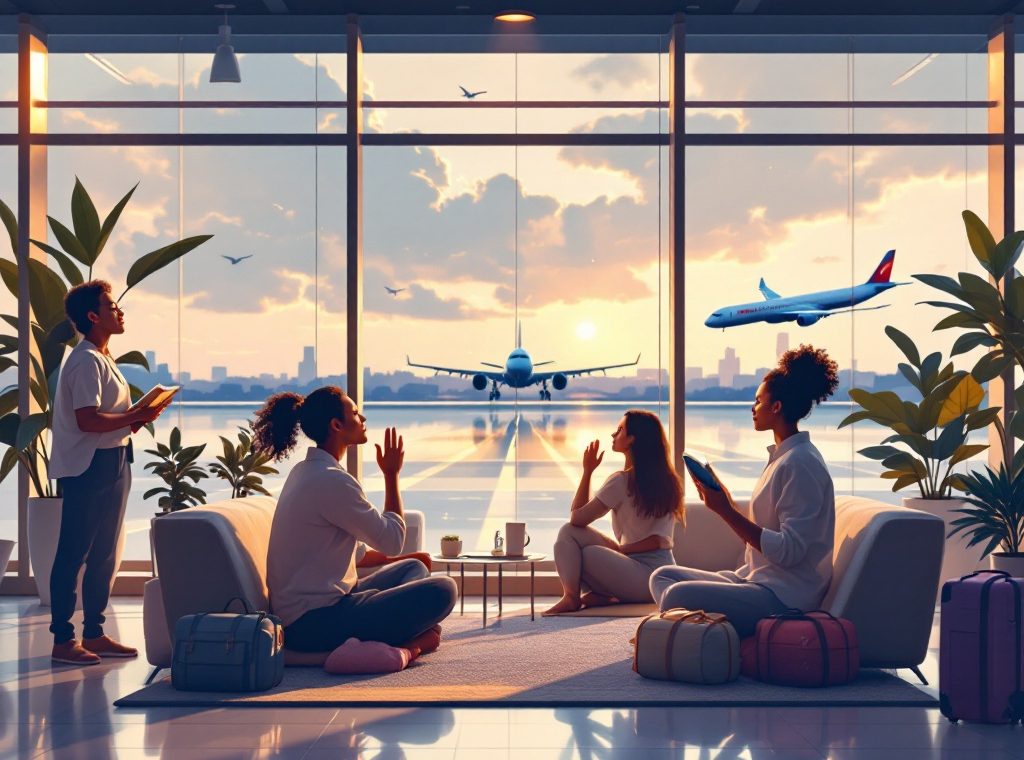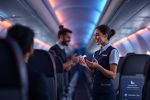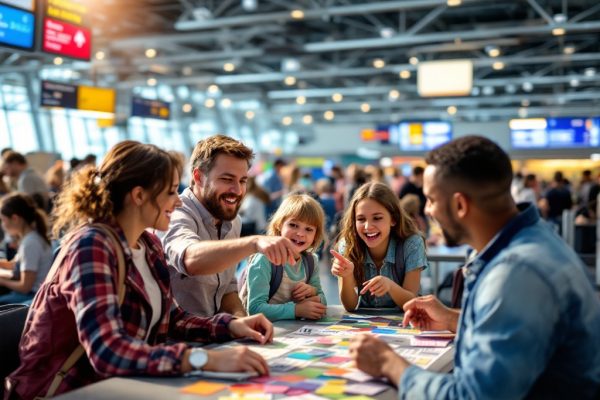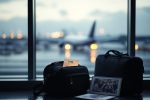How to Deal with Flight Anxiety?
Does the thought of flying fill you with dread? You’re not alone. Flight anxiety, or aviophobia, affects many, but it doesn’t have to ground you. This comprehensive guide explores the causes of flight anxiety, from fear of heights and enclosed spaces to past negative experiences. Discover effective coping strategies, including relaxation techniques, mindfulness exercises, and practical tips for a smoother journey. Learn how Cognitive Behavioral Therapy (CBT) and exposure therapy can provide long-term relief. Take control and reclaim your freedom to fly – read on to start your journey towards a calmer, more enjoyable travel experience.
Important information
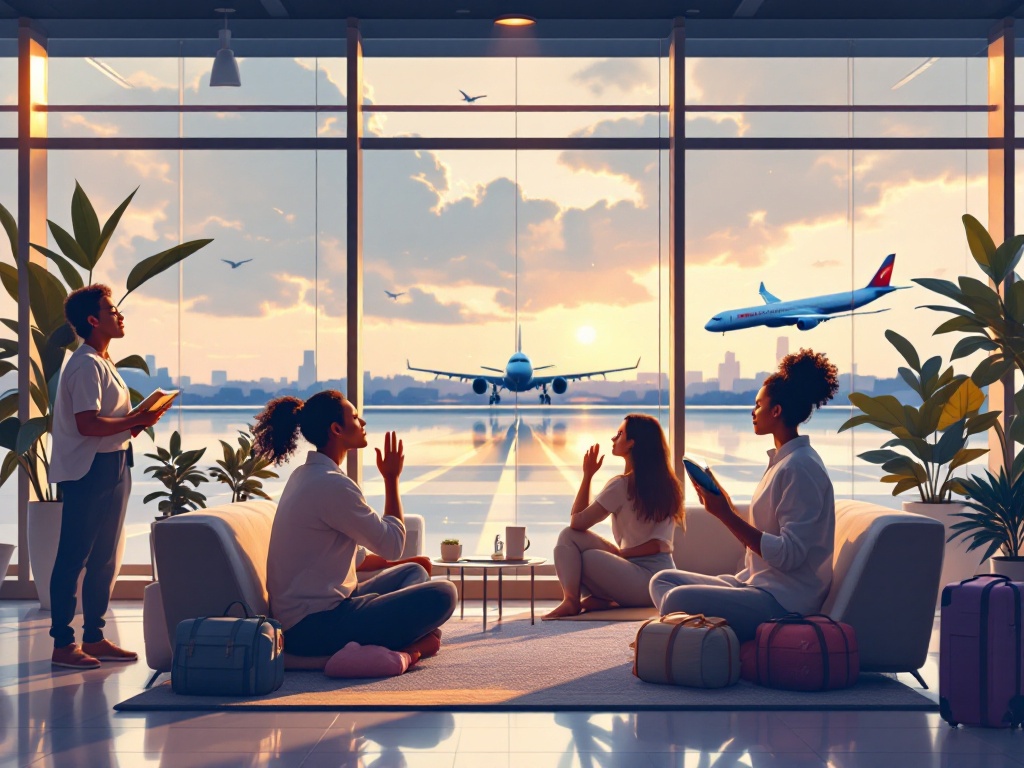
- Flight anxiety (aviophobia) is a treatable fear with various management strategies.
- Cognitive Behavioral Therapy (CBT) and Exposure Therapy are effective therapeutic approaches.
- Relaxation techniques like deep breathing, mindfulness, and grounding exercises can help manage anxiety during flights.
- Understanding aviation safety and flight mechanics can lessen fear and build confidence.
- Practical strategies include choosing the right seat, having a contingency plan, and using distractions.
What is Flight Anxiety?
Aviophobia, more commonly known as flight anxiety, is the fear of flying. This specific phobia, a type of anxiety disorder, doesn’t have to keep you grounded. Here’s how to manage it:
Understand Your Fear. Identifying the root cause of your fear, whether it’s a fear of heights, enclosed spaces, or loss of control, is the first step towards overcoming it.
Seek Professional Help. Therapists can offer personalized strategies like Cognitive Behavioral Therapy (CBT) to manage and overcome your fear.
Educate Yourself. Learning about how airplanes work and the safety measures in place can ease anxieties related to mechanics and potential risks.
Practice Relaxation Techniques. Deep breathing exercises, meditation, and mindfulness can help calm your nerves before and during a flight.
Consider Exposure Therapy. Gradual exposure to flying, starting with short flights or simulations, can help desensitize you to the experience.
Understanding Aviophobia
Aviophobia, also known as aerophobia, is the fear of flying. This fear can manifest in physical symptoms like sweating and a racing heart, accompanied by racing thoughts and catastrophic thinking, where you imagine the worst possible outcomes. While aviophobia can significantly limit travel and life experiences, effective treatments like Cognitive Behavioral Therapy (CBT) help individuals manage and overcome their fear.
Common Triggers and Causes
Several factors can contribute to flight anxiety. Fear of heights (acrophobia) or enclosed spaces (claustrophobia) is often a major trigger. The sensation of losing control, exacerbated by turbulence or unexpected noises within the confined cabin, can also heighten anxiety. Previous negative experiences, such as a prior turbulent flight, or witnessing plane incidents can fuel these fears. Concerns about crashing, terrorism, or mechanical malfunctions also play a significant role.
Physical and Cognitive Manifestations
Physical and cognitive symptoms often occur together. Physical symptoms can include a racing heart, shortness of breath, and nausea. Cognitive issues can involve excessive worrying, catastrophizing, and difficulty concentrating. While these are common indicators, both physical and cognitive symptoms can vary among individuals.
Why Do People Experience Flight Anxiety?
Several factors contribute to flight anxiety. Fear of heights or enclosed spaces is often a major trigger, as is the feeling of relinquishing control. Previous negative experiences, such as severe turbulence, can also fuel this anxiety. Media reports of airplane accidents exacerbate these fears, and some individuals may have a predisposition to anxiety that intensifies their apprehension about flying. Stressful life events or health changes can suddenly trigger flight anxiety.
Common triggers:
- fear of heights,
- claustrophobia (fear of enclosed spaces),
- loss of control.
Other contributing factors:
- past negative flight experiences (e.g., severe turbulence),
- media coverage of airplane accidents,
- preexisting anxiety disorders,
- stressful life events or health changes.
Fear of Heights and Lack of Control
Many anxious fliers fear heights and a loss of control, a combination that can feel especially vulnerable during turbulence. Unexpected events can also amplify anxiety, but studies show regaining a sense of control can mitigate these feelings. Here’s how to take back control during your flight:
Acknowledge your anxiety. Recognizing your feelings is the first step to managing them.
Challenge negative thoughts. Ask yourself if your fears are based on realistic possibilities or unlikely scenarios.
Focus on your breathing. Deep, slow breaths can calm your nervous system.
Engage in distractions. Listen to music, read a book, or watch a movie to shift your focus.
Visualize a positive outcome. Imagine yourself arriving at your destination relaxed and happy.
Impact of Past Negative Experiences
Negative flight experiences can trigger anxiety. Turbulence or witnessing an incident can be particularly unsettling, creating a learned fear response. The individual then associates flying with danger, leading to heightened anxiety and even avoidance of flying.
Recognizing Symptoms of Flight Anxiety
Physical Symptoms
- a racing heart,
- shortness of breath,
- sweating,
- nausea,
- trembling,
- muscle tension,
- stomach upset,
- dizziness,
- chest pain or discomfort.
Cognitive Symptoms
- excessive worry,
- fear of crashing,
- a sense of impending doom,
- difficulty concentrating,
- irritability,
- intrusive thoughts about air disasters,
- panic attacks.
Physical Responses
Flight anxiety can manifest in a variety of physical symptoms, including: a racing heart, shortness of breath, an upset stomach, dizziness, nausea, muscle tension, chest pain or discomfort, and trembling or shaking.
Cognitive Responses
Fear of flying often stems from dwelling on worst-case scenarios, which escalate anxiety. For example, someone might fixate on a potential crash or a sudden medical emergency. Managing this fear starts with identifying and challenging these negative thought patterns.
Preparing for a Flight: Strategies to Reduce Anxiety
Air travel can be anxiety-inducing, but careful planning can significantly alleviate stress. One key factor is selecting the right seat: an aisle seat offers more legroom and easy restroom access, while a window seat provides scenic views and a sense of privacy. Another effective technique is gradual exposure. Begin with shorter flights and progressively increase the duration to build comfort. A well-defined contingency plan is also essential. Packing extra medication and arranging an airport pickup are good examples. Such preparations reduce stress and provide valuable peace of mind.
Tips for Stress-Free Air Travel
- Choose the right seat, an aisle seat offers more legroom and easy restroom access, while a window seat provides scenic views and a sense of privacy.
- Gradual exposure, begin with shorter flights and progressively increase the duration to build comfort.
- Contingency plan, pack extra medication and prearrange airport transportation.
Benefits of Planning
- Reduced stress, careful planning minimizes travel-related anxieties.
- Peace of mind, knowing you’re prepared for unexpected situations enhances your travel experience.
Choosing the Right Seat and Comfort Level
Aisle Seat
enjoy extra space and easy access.
Window Seat
offers scenic views and added privacy.
Over the Wing Seat
provides a smoother ride, especially beneficial if turbulence is a concern.
Booking Advice
book early to secure your ideal spot.
Gradual Exposure to Flying
Gradual exposure conquers flight anxiety one step at a time. Begin by simply imagining flights. Progress to watching videos of takeoffs and landings, then visit an airport to observe the bustling activity. Culminate the process with a short flight. This increasing exposure lessens anxiety and fosters confidence, allowing for personal evaluation.
Imagine flights. Start by visualizing yourself on a plane, focusing on the positive aspects of flying.
Watch videos of takeoffs and landings. This will help you become more familiar with the sights and sounds of flying.
Visit an airport. Observe the activity and the process of planes taking off and landing.
Take a short flight. Experience a real flight to solidify your progress and build confidence.
Exposure therapy starts with visualizations and advances to longer flights. Repeated exposure diminishes fear. Specialized programs combine workshops with this therapy, often led by experienced pilots and therapists. Participants gain insights into flight mechanics and acquire valuable coping strategies.
- Visualizations: Start by imagining yourself on flights to gradually reduce anxiety.
- Longer flights: Progress to longer flights as your comfort level increases.
- Workshops: Participate in specialized programs that combine workshops with exposure therapy.
- Expert guidance: Benefit from the expertise of experienced pilots and therapists who lead these programs.
- Flight mechanics insights: Gain a deeper understanding of how planes work to alleviate technical fears.
- Coping strategies: Learn valuable techniques to manage anxiety during flights.
Creating a Contingency Plan
Traveling can be unpredictable, but a well-structured plan can minimize stress. Here’s how to prepare:
Download entertainment. Having books, movies, or podcasts readily available can combat boredom during unexpected delays.
Pack essentials. Remember to pack snacks and any necessary medications to ensure your comfort throughout the journey.
Use a pre-flight checklist. This helps guarantee you have all essential documents, travel items, and necessities.
Familiarize yourself with the airport. Knowing the airport layout and locating your gate in advance reduces uncertainty and stress upon arrival.
Have a support system. A friend or family member at the airport, or even someone you can call, provides emotional support and comfort.
These preparations increase your sense of control, ultimately easing travel anxiety.
Techniques to Manage Anxiety During Flights
Combat flight anxiety with simple breathing exercises. Try the 4-7-8 technique: inhale for a count of four, hold for seven, and exhale for eight. This rhythmic breathing can soothe your nerves. Another option is alternate nostril breathing: inhale through one nostril, close it, then exhale through the other to promote relaxation. Mindfulness, by focusing on the present, helps regulate emotions. While turbulence can be unsettling, grounding techniques offer comfort. Focus on physical sensations like the feel of your seat or the hum of the plane’s engines. These practices can significantly reduce anxiety and encourage relaxation during your flight.
Breathing Exercises
- 4-7-8 Technique: inhale for four, hold for seven, exhale for eight.
- Alternate Nostril Breathing: inhale through one nostril, close it, exhale through the other.
Grounding Techniques
- Mindfulness: focus on the present moment to regulate emotions.
- Sensory Focus: concentrate on physical sensations like your seat or the engine’s hum.
Breathing Techniques: 4-7-8 and Alternate Nostril Breathing
The 4-7-8 technique is a simple relaxation method: breathe in for 4 seconds, hold for 7, and exhale for 8. This breathing pattern can help ease flight anxiety and promote relaxation during stressful air travel.
Alternate nostril breathing is also helpful. Inhale through one nostril, close it, then exhale through the other, repeating the cycle. This technique can also ease flight anxiety and promote relaxation during stressful air travel.
Mindfulness Techniques and Emotional Regulation
Mindfulness techniques, focused on the present moment, offer valuable tools for managing flight anxiety. By reducing overthinking and promoting relaxation, these practices can significantly ease pre-flight jitters.
Mindful breathing exercises can calm the nervous system.
A body scan meditation helps you connect with physical sensations, grounding you in the present.
Observing thoughts without judgment is another powerful technique, shifting attention from anxious ruminations to present-moment awareness. This shift fosters a sense of calm and control.
Mindfulness cultivates emotional regulation by increasing non-judgmental awareness of your feelings, ultimately leading to better in-flight anxiety management.
Grounding Techniques in Critical Flight Moments
Grounding techniques can help manage your fear of flying, especially during takeoff, landing, or turbulence. One effective method is the 5-4-3-2-1 technique, which uses your senses to lessen anxiety.
- Notice five things you see.
- Touch four things around you.
- Identify three sounds you hear.
- Acknowledge two things you can smell.
- Focus on one thing you can taste.
This exercise reconnects you with the present moment.
Controlled breathing is another helpful tool. Slowing down your inhales and exhales regulates anxiety and calms your nervous system. These practical techniques can make your flight a more comfortable experience.
Effective Coping Mechanisms for Flight Anxiety
Deep breathing techniques, like the 4-7-8 method (inhaling for 4 seconds, holding for 7, and exhaling for 8), can significantly reduce flight anxiety by calming your nervous system. Progressive muscle relaxation, where you tense and release different muscle groups, eases physical tension. Grounding exercises, such as the 5-4-3-2-1 method, also help. With this technique, you name five things you see, four you can touch, three you hear, two you smell, and one you taste, bringing your focus to the present moment.
Positive visualization, imagining a smooth and enjoyable flight, can further reduce anxiety. Guided meditations, available through apps or recordings, offer another path to calmness. Find one that resonates with you.
- Practical Tip 1: arrive early at the airport to minimize rushing.
- Practical Tip 2: pack comfort items, like a favorite blanket or a good book, to ease your mind.
- Practical Tip 3: consider your seat preference: a window seat for the view or an aisle seat for easy access.
- Practical Tip 4: inform the flight crew about your anxiety to allow them to provide support and reassurance.
Deep Breathing and Relaxation Techniques
Combat flight anxiety with deep, slow breaths, especially using techniques like the 4-7-8 method or alternate nostril breathing. Simply focusing on your breath can also calm your nervous system, lowering your heart rate and easing tension. Meditation and mindfulness practices offer further in-flight relief. For deeper relaxation, explore guided playlists to enhance your sense of calm. Creating a peaceful environment, such as a calming personal space, is also key to managing anxiety and reducing stress during your flight.
Grounding Exercises
Look around and name five things you can see, such as a book, a lamp, or a tree. Notice details like colors, shapes, and textures.
Reach out and touch four things, like your clothes, a chair, or a wall. Pay attention to the different textures and temperatures.
Listen carefully and identify three sounds you can hear, such as traffic, birds singing, or the hum of an appliance. Notice the volume and pitch of each sound.
Notice two different smells, like the scent of your perfume, a candle, or fresh air. Try to identify the source of each smell.
Focus on one thing you can taste, such as a piece of gum, a drink, or the lingering taste of a recent meal. Savor the flavor and texture.
Positive Visualization and Guided Meditation
Imagine a smooth, enjoyable flight to ease your travel stress. Positive visualization promotes calm by letting you picture a relaxing journey.
Guided meditation offers a structured approach, shifting your focus from anxiety to tranquility. Both methods effectively combat flight anxiety, helping you relax and manage stress.
Visualizing a peaceful flight creates a sense of calm.
Guided meditation provides tools to control anxious thoughts and feelings during your journey.
Practical Strategies for Anxiety-Free Travel
Practical strategies can ease travel anxiety. Deep breathing and mindfulness techniques are effective, as is visualization—imagining a smooth, pleasant flight. Planning ahead is essential. Arriving early at the airport and packing comfortable items can significantly reduce stress. Relaxation techniques, like guided imagery, also help. Familiarizing yourself with the flight schedule and safety procedures can boost your confidence. During the flight, distractions are your friend. A book, movie, or podcast can keep your mind occupied. If anxiety persists, professional help, such as Cognitive Behavioral Therapy (CBT), can provide coping mechanisms and help manage anxious thoughts.
Practice deep breathing and mindfulness. Visualize a smooth, pleasant flight.
Plan ahead. Arrive early at the airport and pack comfortable items.
Use relaxation techniques like guided imagery. Familiarize yourself with the flight schedule and safety procedures.
Use distractions during the flight, such as a book, movie, or podcast.
Seek professional help if anxiety persists, such as Cognitive Behavioral Therapy (CBT).
Therapeutic Approaches to Manage Anxiety
Cognitive Behavioral Therapy (CBT) targets the negative thoughts associated with flying, helping you challenge their validity. Exposure therapy, conducted in a safe environment, gradually introduces you to flying-related situations. Seeing a therapist provides personalized strategies and support for managing your fear, including coping mechanisms and relaxation techniques to empower you to control your anxiety.
Cognitive Behavioral Therapy (CBT)
CBT targets the negative thoughts associated with flying, helping you challenge their validity.
Exposure Therapy
Conducted in a safe environment, it gradually introduces you to flying-related situations.
Seeing a therapist offers personalized strategies and support, including coping mechanisms and relaxation techniques, empowering you to manage your fear and control your anxiety.
Cognitive Behavioral Therapy (CBT)
Cognitive Behavioral Therapy (CBT) is a powerful tool for managing flight anxiety by helping you understand and change negative thoughts about flying. This therapy gets to the root of your fear, providing practical coping strategies to manage anxiety during flights. CBT has a proven track record with aviophobia, replacing unrealistic beliefs with more rational thinking, ultimately making flying less stressful.
Exposure Therapy
Exposure therapy helps people conquer their fear of flying by gradually introducing anxiety-provoking flight-related situations. The process begins with simple visualizations of flying. Then, it progresses to short flights, and eventually to longer journeys. This repeated, safe exposure reduces anxiety and builds confidence, effectively desensitizing individuals to their flight-related fears. Ultimately, it makes air travel a more manageable experience.
Seeing a Behavioral Health Therapist
A behavioral health therapist can design a personalized plan to help you conquer your fear of flying. Using proven methods like Cognitive Behavioral Therapy (CBT) and Exposure Therapy, they’ll equip you with the tools to manage your anxiety. CBT helps you identify and alter negative thought patterns about flying, a highly effective approach for many. Exposure therapy gradually introduces you to flying-related situations, allowing you to safely confront your fears. Your therapist will also teach you relaxation techniques to use before and during flights, providing practical coping strategies for a calmer travel experience.
Cognitive Behavioral Therapy (CBT)
helps you identify and alter negative thought patterns about flying, a highly effective approach for many.
Exposure Therapy
gradually introduces you to flying-related situations, allowing you to safely confront your fears.
Overcoming Flight Anxiety: Long-term Solutions
Understanding aviation safety can significantly alleviate flight anxiety. Learning about aircraft mechanics, turbulence, and safety procedures can ease worries. For instance, understanding how planes work demystifies flying, while recognizing that turbulence is usually harmless provides comfort. Familiarizing yourself with safety protocols also builds confidence.Sometimes, additional support is necessary. Individualized treatment, such as cognitive behavioral therapy (CBT) and exposure therapy, offers long-term solutions. CBT helps manage anxious thoughts, whereas exposure therapy gradually introduces patients to flying-related stimuli.
Benefits of Understanding Aviation Safety
- Demystifies flying, reducing anxiety about the unknown.
- Provides comfort by understanding that turbulence is typically harmless.
- Builds confidence through familiarization with safety measures.
Additional Support for Flight Anxiety
- Cognitive Behavioral Therapy (CBT): Helps manage anxious thoughts related to flying.
- Exposure Therapy: Gradually introduces patients to flying-related stimuli in a controlled environment.
- Post-flight Journaling: Identifies anxiety triggers, tracks progress, and reinforces positive experiences.
Education and Awareness of Aviation Safety
Understanding aviation safety is crucial for managing flight anxiety. Air travel is statistically much safer than driving, a fact that can be remarkably calming. Airlines and airports adhere to stringent safety regulations, and learning about these procedures can significantly alleviate worries. A grasp of aircraft mechanics and flight physics empowers anxious flyers to rationalize their fears. Furthermore, valuable insights into the complexities of safe air travel are readily available online through resources like aviation safety reports, pilot training information, and air traffic control details.
Individualized Treatment and Professional Help
Therapists create personalized plans using proven techniques like cognitive behavioral therapy (CBT) and exposure therapy to address your specific anxiety triggers. This professional guidance provides you with practical coping mechanisms to manage flight anxiety, offering support and resources for long-term anxiety reduction.
Post-flight Journaling and Reflection
Journaling about the positive aspects of a flight solidifies those memories and reduces future flight anxiety. This post-flight analysis offers valuable insights for your next trip by highlighting effective coping mechanisms. Did deep breathing or music ease your worries? Documenting these successful strategies reinforces positive outcomes and builds confidence. Prioritizing the positive aspects of the flight paves the way for a less stressful next trip.

